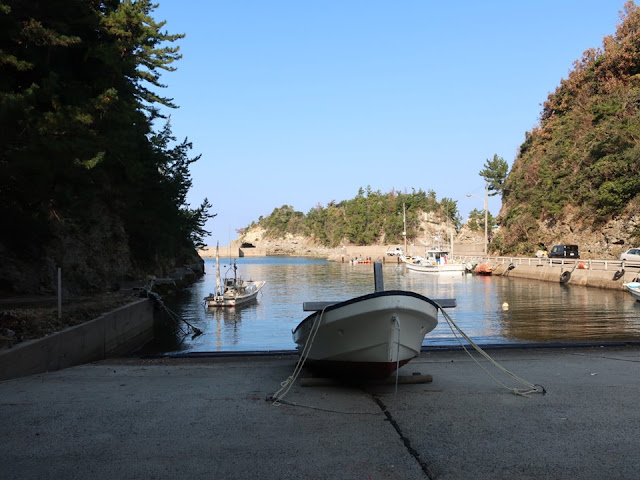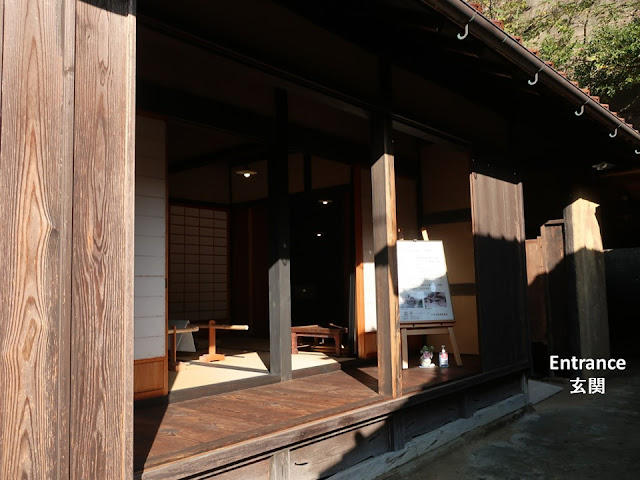There was a large silver mine in western Japan until early 20th century. It supplied
silver even to China. Tomogaura and Yunotsu were ports of shipment back
then. Tomogaura is a tiny fishing village now and Yunotsu is a retro looking
onsen (hot-spring) resort. Those are designated as UNESCO world heritage “Iwami
Ginzan Silver Mine and its Cultural Landscape”.
石見銀山の銀は16世紀前半から20世紀前半まで世界に供給されました。その積み出し港が鞆ヶ浦と温泉津(沖泊)でした。鉱山跡及び街道とともにユネスコ世界遺産”石見銀山遺跡とその文化的景観”に指定されています。今は、鞆ヶ浦は小さな漁村、温泉津はレトロな温泉街です。
The silver was shipped from Tomogaura in early days (16th century), thereafter it was done from Yunotsu and so on. (The map is an exhibit of Shimane Museum of Ancient Izumo)
銀山の開発初期は鞆ヶ浦が積み出し港として利用され、後に温泉津(沖泊)や尾道が使われるようになりました(地図は古代出雲歴史博物館)
Tomokan in Tomogaura、鞆館(鞆ヶ浦)
If you see the mountain side, you can find a small fishing village along the narrow road. It was a fishing and a farming village in the feudal era (Edo period, 1603~1868).
港を背にすると細い道に沿って小さな漁村(鞆ヶ浦)があり、その中に鞆館も立っています。江戸時代は半農半漁の村でした。
It is said Tomokan (former Matsuura’s house) was built in the mid-19th century; its main building (left) was restored. The former barn was rebuilt as an exhibition room and a toilet. It’s rare we can see an old house of ordinary people. The life in the late 19th century is introduced in it.
鞆館(旧松浦家)は、幕末の創建といわれており左側の主屋が復元されています。納屋は展示室とトイレとして再建されています。庄屋ではなく、普通の民家が残っているのは珍しいです。明治・大正期の暮らしを紹介しています。
There are a porch (engawa) and a living room, and is an entrance behind them. They face the mountain to prevent strong sea wind.
海と反対の東向きに縁側と和室があります。そしてその先が玄関。海風を避けるレイアウトです。
There is a kitchen inside the entrance, which has a water jar. They drew water from wells (there were four wells in their village) and kept it in the jar. It continued until the water supply system was built in mid 1960s.
玄関の先は土間の台所。水瓶が置かれています。水道できた昭和40年ごろまでは、集落内に四本あった井戸の水を溜めて使っていました。
There is the living room beside the kitchen. They kept food such as taro and vegetable under the tatami mats. They don’t have a rice field, so they ate taro and burley mainly. I think they sold fish and bought rice when they needed it such as New Year’s.
左を見ると和室があります。座敷の床下には芋や野菜などの食糧を保管していました。水田がないこの地域は、芋や麦が主食でした。正月用の米は、魚を売って手に入れたのだと思います。
There is a wooden floor room behind the tatami mat room.
座敷の奥は板の間です。
An old toilet is on the left. What’s the next room?
左側はかつての大便所、右側の扉の先は、
It’s a bath house. Before the water supply system was built, they took a bath once a week. Each family prepared a bath by turns, and villagers visited there. They reused the water in the bath tub; they sprinkled it on their field. Although Yunotsu hot-spring resort is not so far, they run a bath by themselves. It probably a fun time to take a bath and to chat.
五右衛門風呂の湯屋です。水道がないときは、入浴は週一回。各家で順番に湯を沸かし、みんなで入浴しに行きました。そして、使った水は肥料として畑にまきました。温泉場の温泉津はそう遠くないのですが。でも、わいわいガヤガヤと楽しかったのかもしれません。
Villagers have lived in a small district; their lives were not easy in the old days. Therefore, I guess they enjoyed the New Year Day and their festival a lot. I think, the fun things during life are very relative.
狭い所で暮しを立ててきました。たいへんな努力だったと思います。逆に、正月や祭りなどの行事は、とても楽しみだったでしょう。楽しさは相対的なものだと思います。
Official website (鞆館) http://tomokan.com/ (in Japanese), accessed in April, 2023
Yunotsu、温泉津(ゆのつ)
Yunotsu port is a fishery one at present, however there was a shipment port of silver (Okidomari) in the past beside the road ahead.
温泉津の港は今は漁港です。この先、右側に銀を出荷する沖泊りの港がありました。
The public bathhouse is an origin spring of Yunotsu resort. There is a strange statue in the carpark; it is Asahara Saichi which has horns like a demon. His poem was carved on the side. It relates to Buddhism faith, but I cannot understand the meaning.
温泉津の元湯です。駐車場には、浅原才市の像があります。角が生えています。「如来のお姿こそ かかるあさましき わたしのすがたなり なむあみだぶつ なむあみだぶつ」と書かれていますが、意味をつかめません。
Saichi (1850-1932) was a boat-builder from Yunotsu. After working at various places in Japan, he returned to Yunotsu and start working as a shoe maker (Japanese shoes “geta” are made from wood). He wrote down his poems on a piece of wood while working. His poems are based on his faith. The replicas of his poems on the wooden pieces are exhibited in Shimane Museum of Ancient Izumo. Daisetz T. Suzuki (prominent Zen scholar) introduced his poems (kuchiai), so those become mental support for people. He was an amazing man.
才一(1850-1932)は、温泉津出身の船大工で各地で仕事をした後に帰郷し、50歳ごろから下駄職人を始めました。作業中に信仰の歌が浮かぶと木片に書き留めていました。レアプリカが古代出雲歴史博物館に展示されています。鈴木大拙が彼の歌(口あい)を紹介し、彼の歌は人々の救いになりました。こういう方がいたのですねえ。
There is a sacred spring behind the public bathhouse. It is written that an atomic-bomb disease in Hiroshima was cured by it. Hot spring water of Yunotsu is very famous for its broad range of efficacy.
「湯治の湯」の奥では霊泉が湧出していて、「この温泉で原爆症が治った」とローマ字で書かれています。様々な病に効く湯として知られています。
Shops, shrines and temples are along the narrow street. Yakushi (Bhaisajyaguru or Medicine Buddha)-yu (hot-spring) on the left is one of the highest rated hot springs in Japan.
細いメインストリートの両脇に店や社寺が並びます。左は薬師湯。とても評価が高い温泉です。
Kagura (Shinto music and dancing) is held at this shrine (Tatsu-no-gozen) on every Saturday night. Kagura is very popular in this region.
Reference、参考:https://iwami-kagura.jimdofree.com/ (in Japanese)
龍御前(たつのごぜん)神社では、毎週土曜日の夜に神楽が行われています。石見は神楽が盛んです。
The old residence on the left back is a former village head’s house. It was built more than two hundred years ago. The family lives even until now. (It is NOT open to the public.)
通りの先、左側の古い御屋敷は内藤家庄屋屋敷。築後二百数十年で、今も内藤家が住んでいらっしゃいます(見学不可)。
There is the port at the end of the street.
その先は、波が静かな漁港です。
The view from Atago Shrine at the high ground. It’s a beautiful port town.
高台にある愛宕神社への階段から見るとこんな感じです。美しい港町です。
I stayed at Nakanoya, which draws hot water (upper left) from Yakushi-yu; it’s not so hot.
泊めていただいた「なかのや」さん。お湯は薬師の湯から引いたぬるい濁り湯です(右上)。
Lots of seafoods were served at dinner.
夕食には新鮮な海の幸がふんだんに。
The view of Yakushi-yu from Nakanoya; it’s an alley.
なかのやさんの前から見た薬師湯とメインストリート。路地は狭いです。
Old photos of Yakushi-yu are displayed in Nakanoya. Taking the bathes, enjoying a hot-spring cure, it’s a definitely fun time.
なかのやに昔の薬師湯の写真が飾ってありました。温泉、湯治、幸せな時間です。
Visited in November, 2022
Previous post (luxurious farmhouse in the
neighboring prefecture): Hirokane mansion and Bengara museum、広兼邸とベンガラ館
Next post (huge museum in the same prefecture): Shimane Museum of Ancient Izumo、古代出雲歴史博物館

























Comments
Post a Comment